The statewide Opening Day of Trout Season in Pennsylvania will take place on Saturday, April 5, 2025, beginning at 8 a.m.
By Steven Brodsky
From a news release that was issued by the Pennsylvania Fish and Boat Commission (PFBC) on April 3, 2025:
HARRISBURG, Pa. (April 3) – The Pennsylvania Fish and Boat Commission (PFBC) reminds anglers that the statewide Opening Day of Trout Season is this Saturday, April 5! Anglers may begin fishing at 8 a.m.
Throughout the 2025 season, the PFBC will stock approximately 3.2 million adult trout in 691 streams and 130 lakes open to public angling. These figures, which are consistent with the number of trout stocked over the past decade, include approximately 2.4 million Rainbow Trout; 693,000 Brown Trout; and 125,000 Brook Trout. As with past practice, the average size of the trout produced for stocking is 11 inches in length with an average weight of .58 pounds.
The PFBC will also stock approximately 72,000 trophy-sized trout measuring 14″-20″. Approximately 14,000 golden Rainbow Trout, weighing an average of 1.5 pounds, will also be stocked during preseason and in-season stockings. PFBC partner cooperative nurseries sponsored by sportsmen’s groups and other organizations will combine to raise an additional one million trout that will be stocked into public waterways throughout the trout season.
During the regular trout season (Opening Day through Labor Day), anglers may keep up to five trout (combined species) per day measuring at least seven inches long. During an extended season from September 2, 2025, through February 16, 2026, the daily limit is three trout.
Find Stocked Trout Waters
To locate waters that have been stocked with trout, anglers can review the 2025 Trout Stocking Schedule on the PFBC website (Fishandboat.com). Trout fishing opportunities will continue to be abundant statewide with replenishment stockings occurring throughout the spring.
Get Your Licenses and Permits
Permits and licenses are available using the HuntFishPA online portal and in-person at nearly 700 license issuing agents. All anglers, including youth, are required to have their own account within the licensing system, which can be created either online or at a retail license issuing location. Upon creation of an account, anglers are issued a permanent, individual Customer Identification Number (CID#) that can be used for an improved, user-friendly experience during future transactions.
Fishing from a Boat?
Anglers who plan to fish from a boat on Opening Day of Trout Season are reminded that the PFBC’s cold weather life jacket requirement is in effect from November 1 through April 30. Under this rule, anyone aboard a boat 16 feet or less, including all canoes and kayaks, is required to wear a life jacket. Children ages 12 and under are always required to wear a life jacket while boating in Pennsylvania.
Prepare for Fun!
Whether you’re fishing for trout or any other species of fish this season, take advantage of the PFBC’s online maps to find great places to fish, learn about different types of fishing such as fly fishing and ice fishing, and review catch-and-release techniques for handling fish on the Get Started Fishing page on the PFBC website.
Posted 4-4-25
Fishing regulations pertaining to seasons, sizes, and creel limits at three Pennsylvania lakes have been temporarily lifted by the Pennsylvania Fish and Boat Commission (PFBC) in advance of upcoming dam and infrastructure rehabilitation projects
By Steven Brodsky
The following news release was issued today, March 31, 2025, by the Pennsylvania Fish and Boat Commission (PFBC):
HARRISBURG, Pa. (March 31) – The Pennsylvania Fish and Boat Commission (PFBC) is alerting anglers that effective immediately, all seasons, sizes, and creel limits have been lifted on several PFBC lakes in anticipation of upcoming dam and infrastructure rehabilitation projects.
The impacted lakes and details about the projects associated with each location are listed below:
-
Harris Pond, Luzerne County: A complete drawdown of this 30-acre impoundment is anticipated to begin in fall of 2025. The $1.9 million project will include rehabilitation of the dam embankment and spillway to meet Pennsylvania Department of Environmental Protection (PA DEP) dam safety standards. Once construction begins, the project is expected to last approximately 1.5 years. The reservoir currently offers angling opportunities for warm-water sportfish species including Largemouth Bass, Bluegill, Black Crappie, Chain Pickerel, Yellow Perch, and catfish.
-
High Point Lake, Somerset County: A complete drawdown of this 338-acre impoundment is anticipated to begin in spring 2026. The $5.5 million project will include rehabilitation of the dam embankment and spillway to meet PA DEP dam safety standards. Once construction begins, the project is expected to last approximately 1.5 years. The reservoir currently offers angling opportunities for warm-water sportfish species including Largemouth Bass, Smallmouth Bass, Northern Pike, Walleye, Bluegill, Black Crappie, Chain Pickerel, Yellow Perch, and catfish.
-
Rose Valley Lake, Lycoming County: A complete drawdown of this 389-acre impoundment is anticipated to begin in spring 2026. The $5 million project will include rehabilitation of the dam embankment and spillway to meet PA DEP dam safety standards. Once construction begins, the project is expected to last approximately 1.5 years. The reservoir currently offers angling opportunities for warm-water sportfish species including Largemouth Bass, Walleye, Bluegill, Black Crappie, Chain Pickerel, Yellow Perch, and catfish.
“We have lifted fishing regulations to reduce the number of fish in these lakes in advance of these upcoming projects,” said David Nihart, Chief of the PFBC Division of Fisheries Management. “We encourage anglers to fish these waters and make good use of as many fish as they can prior to the lakes being drained.”
The temporary regulations will be posted on signage around each lake and remain in place until further notice.
HARRISBURG, Pa. (March 31) – The Pennsylvania Fish and Boat Commission (PFBC) is alerting anglers that effective immediately, all seasons, sizes, and creel limits have been lifted on several PFBC lakes in anticipation of upcoming dam and infrastructure rehabilitation projects.
The impacted lakes and details about the projects associated with each location are listed below:
-
Harris Pond, Luzerne County: A complete drawdown of this 30-acre impoundment is anticipated to begin in fall of 2025. The $1.9 million project will include rehabilitation of the dam embankment and spillway to meet Pennsylvania Department of Environmental Protection (PA DEP) dam safety standards. Once construction begins, the project is expected to last approximately 1.5 years. The reservoir currently offers angling opportunities for warm-water sportfish species including Largemouth Bass, Bluegill, Black Crappie, Chain Pickerel, Yellow Perch, and catfish.
-
High Point Lake, Somerset County: A complete drawdown of this 338-acre impoundment is anticipated to begin in spring 2026. The $5.5 million project will include rehabilitation of the dam embankment and spillway to meet PA DEP dam safety standards. Once construction begins, the project is expected to last approximately 1.5 years. The reservoir currently offers angling opportunities for warm-water sportfish species including Largemouth Bass, Smallmouth Bass, Northern Pike, Walleye, Bluegill, Black Crappie, Chain Pickerel, Yellow Perch, and catfish.
-
Rose Valley Lake, Lycoming County: A complete drawdown of this 389-acre impoundment is anticipated to begin in spring 2026. The $5 million project will include rehabilitation of the dam embankment and spillway to meet PA DEP dam safety standards. Once construction begins, the project is expected to last approximately 1.5 years. The reservoir currently offers angling opportunities for warm-water sportfish species including Largemouth Bass, Walleye, Bluegill, Black Crappie, Chain Pickerel, Yellow Perch, and catfish.
“We have lifted fishing regulations to reduce the number of fish in these lakes in advance of these upcoming projects,” said David Nihart, Chief of the PFBC Division of Fisheries Management. “We encourage anglers to fish these waters and make good use of as many fish as they can prior to the lakes being drained.”
The temporary regulations will be posted on signage around each lake and remain in place until further notice.
Posted 3-31-25
Winter will end this month in the Northern Hemisphere
By Steven Brodsky
… and most of this column’s readers are looking forward to the arrival of spring, a season with weather that’s generally more conducive to enjoying activities in the great outdoors.
When and where those activities (camping, fishing, etc.) will take place at night (especially in the absence of ambient light), children and adults can contemplate with awe, Psalm 8:3-5: “When I consider thy heavens, the work of thy fingers, the moon and the stars, which thou hast ordained; What is man, that thou art mindful of him? and the son of man, that thou visitest him? For thou hast made him a little lower than the angels, and hast crowned him with glory and honour.”
Posted 3-3-25
Some of the best bird photos
By Steven Brodsky
… that birders contributed to the Cornell Lab of Ornithology’s Macaulay Library archive in 2024 are accessible for you to view online.
Enjoy: https://www.allaboutbirds.org/news/macaulay-librarys-best-bird-photos-2024/.
Posted 1-13-25
At the right time and right place
By Steven Brodsky
… a gentle encounter with an element of winter can be serendipitous.
On the first evening of winter 2025, this poem by Robert Frost reminds us of this: Dust of Snow by Robert Frost | Poetry Foundation.
Similar (and surprising) beneficial encounters await many of us this season.
Enjoy winter 2025!
Posted 1-1-25
It wasn’t you, nor was it me
By Steven Brodsky
… who made this tree:
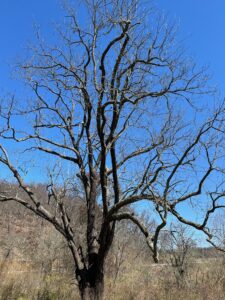
Photo by Steven Brodsky
“Trees,” by Joyce Kilmer: https://www.poetryfoundation.org/poetrymagazine/poems/12744/trees
The tree was photographed yesterday.
The Joyce Kilmer poem was published in August 1915.
This post originally appeared at: Conversations About Faith – delcoculturevultures.com.
Posted 3-25-24, Reposted and Revised 11-21-24
In a proper season
By Steven Brodsky
… appeared this frog (and the shadow it cast upon a lotus leaf):
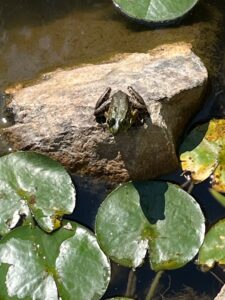
Photo by Steven Brodsky
Ecclesiastes 3 KJV (biblehub.com)
This post appeared in the Conversations About Faith section of this column.
Posted 4-25-24, Reposted and Revised 8-14-24
Exquisite is the monarch butterfly chrysalis stage
By Steven Brodsky
… as pictured here:
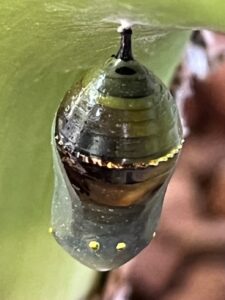
Photo by Steven Brodsky
I can’t say that I find the adult stage of the monarch butterfly to be more exquisite than the monarch chrysalis stage.
Which stage is more exquisite?
Not an easy question (for me) to answer.
It’s easier to simply enjoy seeing these two life stages of the monarch butterfly in the great outdoors!
Posted 8-7-24
Coming into the peace of some wild things
By Steven Brodsky
… with this photo and “The Peace of Wild Things”:
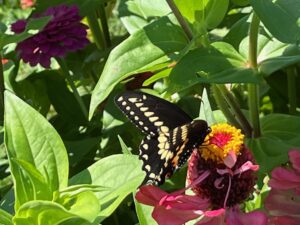
Photo by Steven Brodsky
Posted 7-9-24
‘Nature rarer uses yellow’
By Steven Brodsky
… wrote Emily Dickinson: https://www.online-literature.com/dickinson/poems-series-2/106/.
Thought of the poem today when this early spring spattering of translucent yellow came into view trailside in a National Park:
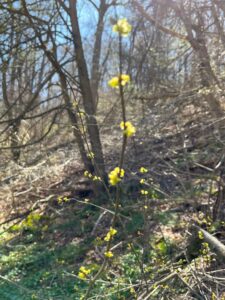
Photo by Steven Brodsky
Some of this column’s readers will recall the Emily Dickinson poem the next time that they take notice of nature’s yellow in the great outdoors.
Posted 3-24-24
A tarantula species was named after Johnny Cash 8 years ago, on February 5, 2016
By Steven Brodsky
… The species is found near Folsom State Prison, the venue where Johnny Cash’s first live album, Johnny Cash at Folsom Prison, was recorded on January 13, 1968. The album was released on May 6, 1968.
Folsom State Prison is located in Folsom, California.
The tarantula species is named Aphonopelma johnnycashi: http://www.sci-news.com/biology/aphonopelma-johnnycashi-new-tarantula-species-johnny-cash-03615.html.
Posted 2-5-24
Most people can relate
By Steven Brodsky
… to the kind of death that was experienced by the character in Seamus Heaney’s poem “Death of a Naturalist.”
Posted 7-12-22
A Conversation With Katie Fallon, Author of ‘Vulture: The Private Life of an Unloved Bird’
By Steven Brodsky
Katie Fallon is a co-founder of the Avian Conservation Center of Appalachia. She’s worked with many species of raptors and other kinds of birds. Katie’s books include Cerulean Blues (2011) and the recently released Vulture: The Private Life of an Unloved Bird. Her essays have appeared in a number of literary journals. She has a lifelong love of nature. I’ve heard that the first word she ever spoke was “bird.”
Your new book gives vultures, particularly turkey vultures, the positive attention these non-predator raptors deserve. What brought about your interest in these maligned birds?
I’ve been fascinated by vultures for at least fifteen years. There was a roost near where I lived in West Virginia; every day I’d drive by this big, old dead tree with ten or so turkey vultures hunched in it. They became a familiar sight, and I looked forward to seeing them. Vultures are big and kind of dramatic, and in flight, there’s nothing more beautiful. In addition, they’re the ultimate recyclers—they turn death into life.
Many people in the U.S. have an aversion to vultures. Speak about this.
I think vultures remind people of their own mortality. It can be a little creepy to think about a large, dark bird waiting to consume your body when you die. In general, I don’t think people in the US are comfortable with thinking of our bodies as food. Vultures remind us that life will continue after we die, and that some life will continue because we die. They remind us of our animal bodies. Which can be unnerving!
In the absence of vultures, we’d have major health issues to contend with. Tell us why.
Vultures clean up our ecosystems by removing animal carcasses that could potentially contaminate soil and water. They can eat animals that have died of anthrax and botulism. In the absence of vultures, mammalian scavengers could increase in number, and many mammalian scavengers such as raccoons, skunks, feral dogs and cats can spread rabies; vultures do not. Several vulture species in India have suffered catastrophic population crashes in the last twenty years, and public health has suffered. India leads the world in human rabies cases, and the number of cases has increased as the number of feral dogs increased in the absence of vultures.
People get close to vultures by attending your presentations that feature non-releasable birds. How are these birds acquired? How are they trained?
The nonprofit I co-founded, the Avian Conservation Center of Appalachia, keeps eight non-releasable raptors for educational purposes (you need permits from the US Fish & Wildlife Service to do this, of course – the birds aren’t pets or personal property). All of our birds were injured wild birds that cannot return to the wild. We have three vultures. Lew the turkey vulture was hit by a car and suffered an injury to his shoulder that prevents flight. His “girlfriend,” Boris, was shot in the wing, and by the time she reached us the bone had already healed incorrectly. Our black vulture is Maverick, and he was hit by a car, which resulted in a shoulder injury that prevents adequate flight.
Our birds are all trained using positive reinforcement. We avoid negative reinforcement and punishment, and we try to empower the birds to have some control over their environments. We condition behaviors by offering food rewards when the birds perform the behaviors. Vultures (especially our black vulture!) learn quickly, and they are a lot of fun to work with.
What myths and misunderstandings about vultures do these presentations help to dispel?
People are surprised at how clean and charismatic the vultures are – and how beautiful they are up close, despite their featherless heads.
What vulture behaviors do people find to be most interesting?
People often ask if vultures throw up on us; our education vultures usually don’t (unless they get scared). Vultures also expel liquid waste on their legs and feet, probably to clean them as well as to keep cool. This often fascinates people as well.
Which species of vulture are found in Pennsylvania and neighboring states?
We have turkey vultures and black vultures. During the last Ice Age we may have had California condors, too, and possibly some other now-extinct vultures.
What has been learned about migration of these species?
Hawk Mountain has taken the lead on turkey vulture migration research. Dr. Keith Bildstein and his team have placed transmitters and wing tags on turkey vultures all over the Americas. They’ve learned that our eastern turkey vultures are partial migrants—some spend the winters in Florida, some on the New Jersey shore, some in Virginia, and in many places in between. Many western turkey vultures are complete migrants, leaving their breeding ranges in Canada and heading all the way to South America. And still others in the American southwest migrate into Central America and return. It’s fascinating how the different subspecies have different migratory strategies. Dr. Bildstein and his colleagues have ongoing research projects about turkey vulture migration, and are discovering more all the time.
Vultures have spectacular flying ability. What makes this possible?
Turkey vultures are very light – they have almost the same wingspan as a bald eagle but weigh less than half what an eagle weighs. Their wings are long and broad, and are made for soaring.
How high can they fly?
The Ruppell’s vulture holds the record for the highest-flying bird. Unfortunately for that individual, it was hit and killed by a jet flying over Africa at 37,000 feet.
Vulture: The Private Life of an Unloved Bird informs readers about lead toxicity in vultures. What is the extent of the problem? How do vultures ingest lead?
Vultures (and eagles, hawks, crows, ravens, and owls) can ingest small pieces of spent lead ammunition in animal carcasses or “gut piles” left by hunters. When someone shoots a white-tailed deer, for example, the deer is usually field-dressed, and many of the organs are left. This can be a delight for vultures and other scavengers! In ecosystems, scavengers often follow the big predators to clean up the leftovers; here, the same thing is happening—a human is the big predator, a gut pile is the leftover, and a vulture or eagle is the scavenger. However, if small lead fragments are still in the gut piles, avian scavengers can inadvertently ingest the lead and become sick. Lead toxicity from spent ammunition is the biggest obstacle in the way of California condor recovery.
The Avian Conservation Center of Appalachia provides rehabilitation for injured birds. What kind of care do vultures receive?
We’ve treated vultures with a wide variety of injuries and ailments—broken bones, head trauma, lead toxicity, soft tissue injuries. Every bird we admit receives an immediate comprehensive examination by an avian veterinarian, and is then treated as necessary with antibiotics, antifungals, anti-inflammatories, fluid therapy, or chelation therapy. They also receive orthopedic surgery if necessary. We do our best to get the birds back out in the wild if possible.
It must be very joyful to enable an injured bird to regain flight ability. Please tell us about a memorable release.
Two and a half years ago we released a female turkey vulture that had been shot with a shotgun—she had three pellets embedded in soft tissue. We had to leave the pellets in her body because removing them would cause damage. Once she was nursed back to health, we released her wearing a transmitter to track her movements. We learned that she travels to northern Georgia in the winters and comes back to West Virginia in the breeding season. We are thrilled that this vulture was able to return to the wild—and thrive!
Vulture watching is growing in popularity. Turkey vultures are very widespread. Where are some of the best places and times to observe them?
In many parts of the southeastern United States, you can see turkey vultures any day of the year in a variety of habitats. In the winter, vultures can be observed roosting together in and near many cities: in Virginia, check out Leesburg, Staunton, Radford, Pulaski, and Charlottesville; in West Virginia, many vultures can be observed migrating in the fall over Hanging Rock Tower in Monroe County and over Harper’s Ferry in the eastern panhandle. During the summer and fall, the overlook at Cooper’s Rock State Forest near Morgantown, WV, is a sure place to see turkey vultures. Hawk Mountain in Pennsylvania, of course, is an excellent place to watch turkey vultures and birds of prey during migration, especially in September and October.
What stimulated your interest in nature?
I’ve always been an outdoors person. I grew up in northeastern Pennsylvania, and I had horses as a kid. I spent a great deal of time with my horses, trail riding and competing, and when I got a bit older I often went hiking and camping with friends and family. One of my favorite childhood hiking spots was Ricketts Glen State Park—it’s filled with hemlock trees and many gorgeous waterfalls. It’s definitely worth checking out if you visit northeastern PA.
Was “bird” your first word?
Yes! My parents had bird feeders in their yard when I was a baby (well, they still do) and my mother says she used to hold me in front of the window to show me the birds at the feeder. One day, she said, “Look at the birds! Look at the birds outside.” And I nodded and said, “Bird.” I haven’t stopped talking about them since.
Katie Fallon’s website address is: www.katiefallon.com.
Posted 4-6-17, Reposted 10-29-19